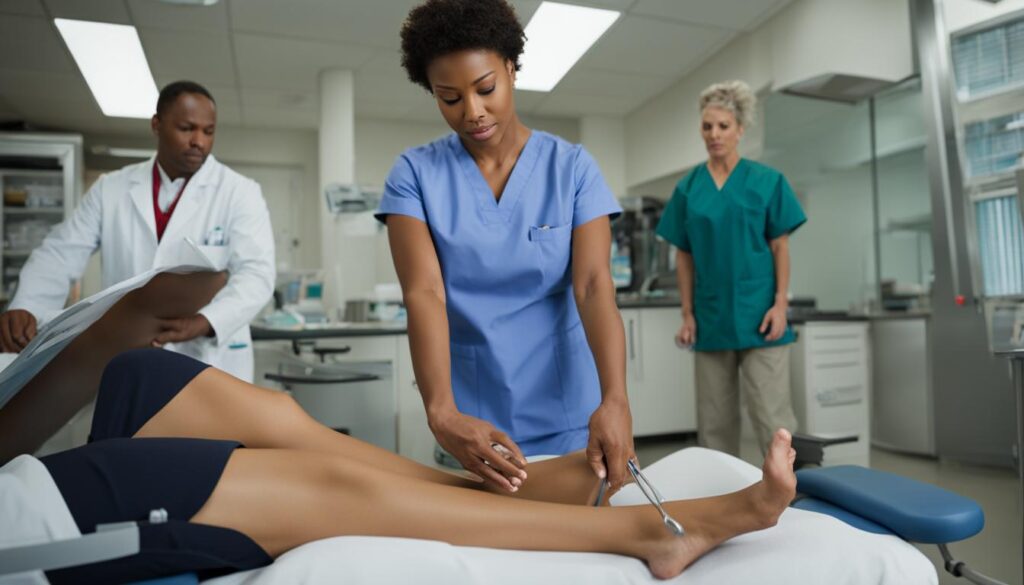Leg cramps are an involuntary muscle contraction that can result in sudden, intense pain. While often temporary, the discomfort can persist, making prevention key. With the right approach, you can sidestep this unwelcome disturbance and continue your activities unhindered. Today, we’re going to discuss the leading leg cramp prevention techniques and natural remedies for leg cramps.
Leg cramps usually involve your calf muscles, but you can also experience cramps in your quads and hamstrings. The pain can range from a mild ache to an unbearable throbbing, often waking people from sleep. The good news is, there are both proactive and reactive measures you can take to manage and prevent such cramping. Let’s get right into it!
Key Takeaways
- Preventing leg cramps often involves steps like proper hydration and regular muscle stretching.
- Recognizing the triggers and causes of your leg cramps can help fend off future episodes.
- Adopting healthy lifestyle habits playing a crucial role in cramp prevention.
- Natural remedies such as certain foods and nutrients can considerably mitigate leg cramps.
- Medical professionals offer effective tips for preventing and managing leg cramps.
- Incorporating specific exercises and stretching routines into your daily schedule can minimize cramp occurrence.
- A suitable diet can fortify your muscle health, reducing your susceptibility to leg cramps.
Understanding Leg Cramps and Their Causes
Leg cramps, colloquially known as charley horses, are involuntary contractions of the muscles that most commonly affect the calf muscle. The unpredictable nature of these cramps, coupled with the severe pain they often cause, can make them a significant disruption to daily life. To provide some muscle cramp prevention tips, they require an understanding of their causes.
Primarily, leg cramps result from muscle overexertion, dehydration, and remaining in prolonged positions such as sitting or standing for extended periods. Specifically, people who engage in high-intensity workouts without adequate hydration and rest may experience these cramps.
“Keeping muscles relaxed and maintaining a well-hydrated body can help in preventing cramps.”
In addition, certain medical conditions and medications can also lead to leg cramps. For instance, conditions like arterial narrowing, nerve compression, and deficiency of essential minerals and electrolytes contribute to muscle cramps. Regular medications such as diuretics, notorious for depleting the body of essential electrolytes, can be significant causes of cramps.
| Risk Factors | Description |
|---|---|
| Age | Older adults encounter more muscle cramps due to reduced muscle mass. |
| Lack of Physical Conditioning | People who do not regularly exercise or stretch their muscles are more prone to cramps. |
| Excessive Sweating | Lost fluids and salt from excessive sweating can cause muscle cramps. |
| Pregnancy | Expectant mothers often experience muscle cramps due to circulatory changes. |
| Underlying Medical Issues | Conditions like diabetes, peripheral artery disease, and thyroid disorders increase the risk of cramps. |
| Overweight | Being overweight or obese puts increased pressure on the legs, increasing cramp likelihood. |
Understanding the aforementioned causes of leg cramps better equips us to manage and prevent them effectively, providing a pathway toward pain-free, unrestricted movement.
Leg Cramp Prevention Techniques
In confronting the discomfort of leg cramps, incorporating preventative measures in your daily diet and lifestyle is essential. This section focuses on advisable techniques on how to prevent leg cramps, highlighting the standard facets of lifestyle that can be adjusted to facilitate this process.

In tandem with stretching, healthcare experts also highlight the importance of maintaining a healthy lifestyle to keep these unwanted muscle contractions at bay. This involves integrating regular movement and exercise throughout one’s day, focusing particularly on the leg muscles.
- Engaging in daily exercise: This doesn’t necessarily have to be intense workouts, even brisk walking or cycling can make a significant difference.
- Maintaining a healthy weight: Excess weight puts extra pressure on your muscles and can thus exacerbate leg cramps.
- Staying well-hydrated: Hydrating adequately every day is crucial in warding off muscle cramps due to its role in proper muscle function.
| Healthcare Expert Advice | Objective |
|---|---|
| Regular Leg Cramp Prevention Stretches | Loosening muscles and increasing flexibility |
| Daily Exercise and Movement | Keeping muscles active and fit |
| Healthy Weight Maintenance | Decreasing pressure on leg muscles |
| Adequate Hydration | Ensuring proper muscle function |
“Prevention is better than cure, and this applies to muscle cramps as well. Simple lifestyle changes can make a big difference in preventing these painful occurrences.”
Exercises to Prevent Leg Cramps
Exercising regularly and effectively can play a cardinal role in preventing leg cramps. Regular stretches and low-impact workouts such as stationary bicycle sessions before bedtime are considered very beneficial. The objective here is to keep the leg muscles stomped-down, yet flexible to bypass any sudden, painful convulsions.
Leg Cramp Prevention Stretches
Stretching for leg cramp prevention is a proven tactic to avoid this discomfort. Ensuring regular bouts of calf and hamstring stretches significantly reduces the occurrence of leg cramps. One can simply begin by adopting standing stretches. For instance, place your foot flat on the ground, lean forward while keeping the heel intact with the floor. Stretch to a point until you feel your back leg’s muscles gently elongating. The key is to stretch just enough to feel the pull without experiencing pain.
Stationary Bike Riding Before Bed
Interestingly, riding a stationary bike for just a few minutes before bedtime makes a considerable difference in preventing leg cramps. This relatively effortless exercise aids in loosening up the leg muscles, enhancing their flexibility, and reducing the chances of an unexpected leg cramp.
Remember, the prevention of leg cramps largely relies on understanding your body’s needs, regular stretches, and keeping your muscles active through appropriate exercises. It’s important to listen to what your body tells you and adjust your exercise routine to incorporate effective leg cramp prevention techniques.
Diet for Preventing Leg Cramps
In combating nagging leg cramps, what you eat can be more impactful than you may think. Your diet plays a significant role in muscle health and cramp prevention. Adopting a diet rich in essential minerals and maintaining high fluid intake can be a game-changer in your quest to ward off leg cramps.
Important Vitamins and Minerals
Minerals like potassium, calcium, and magnesium are instrumental for maintaining muscle health and warding off cramps. They support proper muscle function and neurotransmission, helping muscles to contract and relax properly. Incorporating leg cramp prevention supplements into your diet that are rich in these minerals can be a progressive stride in dealing with leg cramps.
Foods to Include in Your Diet
Selecting foods high in these essential minerals can make a notable impact on your muscle health. Staples like bananas, dairy products, leafy greens, and nuts are not just delicious additions to your meals but excellent sources of these muscle-friendly nutrients. Foods like these constitute a potent diet for preventing leg cramps.
Hydration and Its Role in Muscle Health
Never underestimate the role of hydration in proper muscle function. Dehydration can lead to mineral imbalance in your body, leading to leg cramps. Ensuring you drink ample fluids throughout the day facilitates proper electrolyte balance crucial for muscle function and leg cramp prevention.





